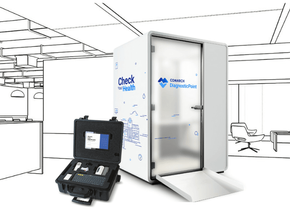Revolutionising insurance with big data

Insurance is in a new age of digitisation. Over the past few years, insurtechs have perforated the market to offer their own products in a B2C capacity or supply established insurers in B2B models.
The word “revolution” has been synonymous with a rapidly changing insurance industry, none more so than for digital strategist and author Bernard Marr. He says: “Insurtechs are revolutionising the insurance industry by exploiting the mammoth potential of big data.
“Big data allows insurtechs to offer personalised policies, streamlining the claims process using predictive analytics for fraud detection and claim probability. A key takeaway is how insurtechs leverage big data to improve customer experiences through chatbots, and AI-driven claims processing, which is shifting the industry from being reactive to proactive."
Fujitsu UK’s CTO and FS&I of Data & Applied Intelligence Hugh Coughlan agrees on the transformative impact of big data, particularly its role in “redefining underwriting and risk assessment”.
Meanwhile, Persistent Systems’ Head of Solutions for Europe, Devashish Mishra, highlights big data’s ability to “automate complex insurance processes” through its relationship with AI and machine learning.
Such advancements, and the relationship between big data, AI, and machine learning is saving “insurers a lot of time and enabling human experts to focus more on the marginal cases where their expertise is most required", according to Viren Patel, Financial Services Industry Strategist at Workday.
So, how is big data and its relationship with AI and machine learning revolutionising insurance, and how does the relationship work?
The triumvirate of AI, machine learning, and big data
For Persistent Systems’ Mishra, “big data is the bedrock of building data models to support insurance operations.”
He explains: “The first set of big data comes from internal systems of policyholder master records, billing, accounting, and claims. This is then merged with third-party data to create data clusters for business processes.
“The next step is to create an analytics platform to analyse the data clusters. Additionally, self-service options should be provided to business users for collating insights on historical data on products, claims, and customer segmentation.
“Once self-service maturity is in place, predictive analytical ML models can be built to enable customisation with self-driven rules and extracts for root cause analysis, triage, and trends.”
It is clear, then, that big data is the symbolic fuel for machine learning (a type of AI), but what of AI’s broader role? Coughlan expands: “AI provides the larger framework within which machine learning operates, creating intelligent systems capable of problem-solving, decision-making, and complex reasoning.”
Marr breaks the relationship down to its nub: “Big data is the vast pool of information, machine learning is the ability to learn from this data without being explicitly programmed, and AI is the broader concept where machines execute tasks in a way we consider smart.”
The result is a palpable synergy, “making it quicker and easier for customers to ensure their new home or car is fully and fairly insured,” says Patel. According to Coughlan, the relationship can also be leveraged to “bolster risk assessment, unearth fraudulent activities, streamline underwriting processes… and provide the most personalised and accurate offerings, that suit the true needs of the customer.”
It is in this breakdown we come to the core purpose of insurtech innovation, to make insurance offerings more customer-centric – improving the experience for them.
Why are legacy insurers so slow to adapt?
Improving the customer experience is clearly important for any business, let alone insurance, as it, evidently, leads to greater customer acquisition and retention.
So, why are legacy insurers so far behind in their digital upgrade roadmaps? With oceans of data from years of operationality, it arguably makes more sense for technical innovation to be at the fingertips of legacy players than at challenger insurers where it is used to great effect.
For Marr, it is perhaps more an inability to integrate new models than a lack of desire, although a risk-averse culture – the default mindset of insurers – is slowing the pace of innovation too.
He says: "Legacy insurers are often anchored to dated systems and processes that deter them from capitalising on the big data goldmine. These archaic infrastructures impede the integration of modern data analytics tools.
“Besides, a culture that is risk-averse and clings to traditional business models can also curtail innovation. The larger size of legacy companies, compared to nimble insurtech startups, often means they have more bureaucratic inertia which can slow down the adoption of cutting-edge technology."
However, Workday’s Patel feels this inertia could be wearing off. “For years insurers have used tried and tested methods for claims analysis and underwriting, which have worked, but now they are recognising the need to embrace change and digital innovation. This is a mindset shift for traditional insurers who are not used to working with tech partners,” he explains.
"We are seeing a shift in the employment market, where talent let go by big tech companies is being snapped up by more traditional organisations. Interestingly, however, it is those who are starting to use smarter, AI-driven recruitment tools in their back offices who are best able to find the kind of digital talent and skills they need to drive innovation and progress.
"There has been some progress, particularly in customer-facing applications, but at the back end, most continue to use legacy IT environments where valuable data assets remain siloed in different departmental systems.”
Big data: Keeping pace with customer expectations
So, while legacy insurers may be starting to wake up and smell the roses, they must do so quickly in order to ensure customer retention rates stay stable, for as innovation evolves in the insurance space, customer expectations do in tandem.
Marr says: “Millennial and Gen-Z customers are more likely to prefer usage-based insurance and are comfortable sharing data for a tailored experience. Also, the expectation for seamless, almost instant, digital interactions is on the rise. Customers are embracing insurtechs that offer mobile apps, AI-based virtual assistants, and quicker claims processing.”
As younger consumers get older, these expectations will soon become the norm. Patel notes that “younger customers demand this kind of experience as standard now. They don't want generic insurance products or inconvenient insurance experiences, and smart insurers are implementing plans to meet those needs."
The future of big data: Expanded use cases
With smart insurance set to define the future of the industry, Marr believes insurtechs “have just scratched the surface of what big data can achieve”, a further warning to legacy players currently behind on technological innovation.
He adds: “In the future, we can expect more interconnected devices feeding real-time data, enabling dynamic pricing models that evolve with user behaviour. Blockchain technology could be integrated with big data for transparent and secure transactions. Insurers could also embrace augmented and virtual reality for loss assessments and customer interactions.”
Patel offers further use cases that big data could support in the future: "We are moving into a world where you can get a better price on your health insurance if you exercise better, and you can get that data from a smartwatch. Just imagine how much data Apple could access that would help in insurance."
"You can already get a better price on your car insurance if you drive more safely, and your insurer can access that data through a smartphone app. But how about daily or hourly pricing that changes how much you pay based on whether you drive at times or in locations where you are more likely to have an accident? That's becoming a reality."
It is clear then, as Marr puts it, that “big data’s potential is limitless, and harnessing it innovatively will be key to staying ahead”.






